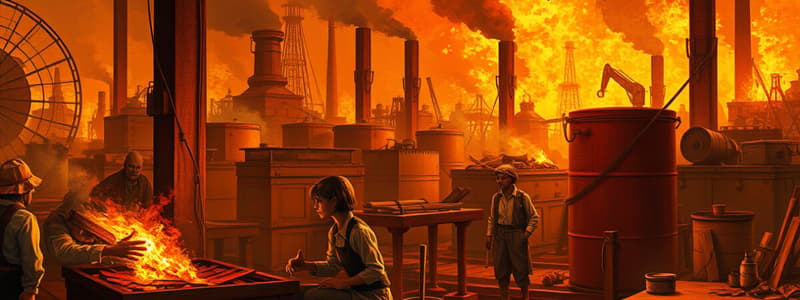Podcast
Questions and Answers
What are the pros of Working Conditions and Wages?
What are the pros of Working Conditions and Wages?
- Long hours
- Opportunities to make money (correct)
- People had work (correct)
- Conditions were safe
Child Labor provided only benefits with no downsides.
Child Labor provided only benefits with no downsides.
False (B)
What was a con of the Changing Role of Women during the Industrial Revolution?
What was a con of the Changing Role of Women during the Industrial Revolution?
Women did not have equal rights as men for payment.
What are the cons of Conditions in the Coal Mines?
What are the cons of Conditions in the Coal Mines?
The population increase due to Urbanization caused an increase in ______.
The population increase due to Urbanization caused an increase in ______.
What was a pro of Education during the Industrial Revolution?
What was a pro of Education during the Industrial Revolution?
What drove the Changing Class Structure during the Industrial Revolution?
What drove the Changing Class Structure during the Industrial Revolution?
Industrial Production allowed other European nations to thrive in the market.
Industrial Production allowed other European nations to thrive in the market.
What is a pro of Modern Inventions?
What is a pro of Modern Inventions?
What are the cons of Modern Buildings?
What are the cons of Modern Buildings?
Flashcards are hidden until you start studying
Study Notes
Working Conditions and Wages
- Opportunities for employment improved, allowing families to earn income.
- Poor working conditions created constant danger from machinery.
- Workers faced long hours with low wages.
Child Labor
- Children contributed to family income through work.
- Low pay and unsafe work environments were prevalent.
- Children were at higher risk for diseases due to poor conditions.
Changing Role of Women
- Increased work opportunities allowed women to financially support families.
- Women received unequal pay compared to men for similar work.
- Factory conditions posed health risks and dangers from machinery.
Conditions in the Coal Mines
- Coal mining was vital for powering new inventions and creating job opportunities.
- Mining work involved harsh conditions and significant health risks, including lung diseases.
Urbanization
- Migration to cities provided chances for individuals to earn money.
- Rapid population growth led to increased disease rates, higher crime, shorter life expectancies, and inadequate housing.
Education
- Government funding for schools increased, promoting education.
- Laws mandated school attendance, aiming to reduce illiteracy.
- Many workers remained illiterate; laws focused more on quantity of schooling rather than quality.
Changing Class Structure
- Higher job demand created more employment opportunities.
- Increased access to education allowed some individuals to become wealthy.
- Poverty levels rose, with a growing divide between social classes due to population influx seeking jobs.
Industrial Production
- British industry dominated, contributing to significant economic profits.
- This dominance posed challenges for other European nations to compete in industrial markets.
- Industrial technology was costly, limiting access for other countries.
Modern Buildings
- Advancements in architecture led to improved housing and construction.
- Overpopulation issues resulted in inadequate living conditions for the lower class.
- Air pollution from factories disproportionately affected lower-class communities.
Modern Inventions
- International competition spurred innovation and increased factory productivity.
- Increased reliance on electricity heightened dependence on coal for power generation.
Studying That Suits You
Use AI to generate personalized quizzes and flashcards to suit your learning preferences.



